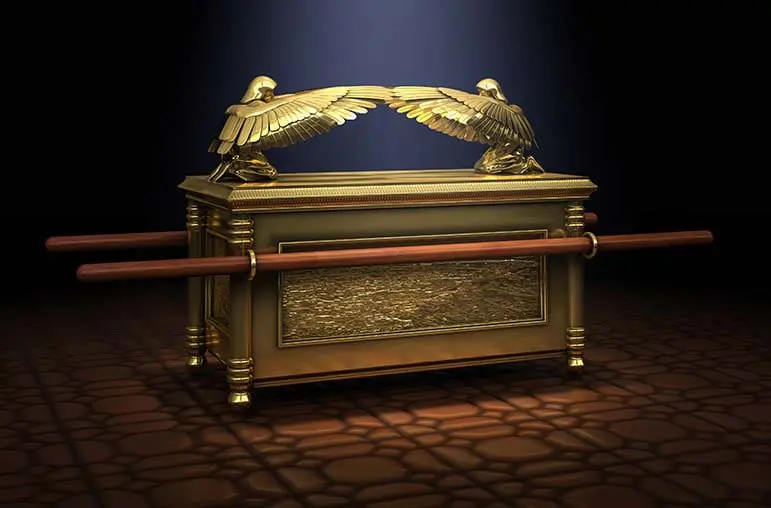
Mercy Seat is a term that piques the spiritual interest that is innate in most humans; that is, it may excite you, spark interest in you, irritate you, annoy you, or make you angry. Pique is one of those words whose meaning is defined in context. Mercy seat is also defined in the context of the material world and the spiritual universe. The very idea that there is a place of mercy incorporated into a religious worldview is exciting for those looking for mercy unless one rejects the particular religion that offers such a thing. Then, it can be quite irritating. The empirical Mercy Seat is the covering of the Ark of the Covenant as described in Exodus. The spiritual Mercy Seat is covered by Jesus Christ.
The Greek word for mercy seat in Hebrews 9:5 is hilasterion and is the translated word used to describe the brazen altar spoke of in Ezekiel 43:13-15. The brazen altar was the place of removal of sin…with the shedding of blood. There is no greater mercy than the removal of sin. With the removal of sin comes the opportunity to have right standing with God, access to His person, and the promise of eternal family fellowship. We may call Him father, and He most certainly claims us as children. Now, this prospect is exciting to some and irritating to others.
One must contemplate the full picture to understand the greatness of the Mercy Seat. A stark reality that will pique an uninformed Christian, that is, make them angry, would be the fact that Judaism and Christianity are blood sacrifice religions. Are you irritated or interested? The thing is, it took the Blood of God to satisfy the price of sin. God could not provide this necessary blood unless He became a man and lived a life in creation as a man. One of Jesus’ self-christened nicknames was the “Son of Man.” It was His favorite title when conversing with people. Just think, the Son of God began calling Himself the “Son of Man” before He became the baby named Jesus. It was this man, also called the Lamb of God, born of a woman in a sheep shed, who provided the perfect blood sacrifice to not only cover but wash away one’s sin. His blood on the Mercy Seat has everything covered.
Moses was given instructions to build a box of wood overlaid with gold. It had rings at each leg and two wooden poles covered with gold inserted through rings on both sides of the box. This configuration was designed to move the box without humans touching it. A thick lid was to be made of pure gold with the figure of a single angel on each end. These angels were to be solid gold and beaten into shape. They were to be part of the cover, not attached, but an integral part of the creation. The wings of the angels stretched out over the lid, and that was the place where God’s presence, in concentrated form, would dwell. At the top of this lid, the blood of lambs would be sprinkled for the propitiation of sin. It was called the Mercy Seat in the King James Bible and the cover of atonement in the New International Version.
Since God’s presence was holy, then the ark was holy. People could not touch the holiness of God’s person, which is why the poles were used to move the Ark of the Covenant around. In the Old Testament, God did not tolerate being touched by sin. Some died for this faux pas. The blood of animals covered the Israelites if applied once a year. Aren’t you glad people today can be covered in perpetuity by the Blood of Jesus? The Covenant Law, a bowl of manna, and Aaron’s Rod were in the Old Testament Ark. The law being the Ten Commandments, manna was the bread from heaven as provision for Israel, and the rod was for the guidance and protection of the “flock.”
A distinction should be made here. There is a difference between the Covenant Law and the Book of the Covenant. The Book of the Covenant consisted of the rules and regulations of Israeli spiritual life. It was incorporated into the Torah, although some scholars have reduced it to the Exodus manuscripts. In the tabernacle furniture arrangement, the Book of the Law was placed beside the Ark to be a witness to the people’s sins. The Rod was placed in front of the Ark as a sign to the rebellious (Numbers 17:10).
Mercy Seat Or Cover Of Atonement
Everything a person could do wrong was generally addressed in the Ten Commandments. The Mercy Seat, or Cover of Atonement, overruled the penalties of the “Law of God in words” when the appropriate Blood was applied. People want to put God in the box, but God is sovereign and above the box. Since His presence dwells above the Mercy Seat, He has the divine option to show mercy–He wants to show mercy. Think of it this way: God’s words are powerful, have authority, and function as an agent of holiness. They are divine; however, they are not God. They are not supposed to be worshipped. The words may be eternal, but their punitive power can be negated by a lawgiver, a judge who decides on a case by the spirit and humility of the offender. If a man, woman, or child accepts the Blood sprinkled on the Mercy Seat, trusts it, and is not afraid, then God is their salvation. Mistakes are made, but the Blood is preeminent over the Law. Willful disrespect of the Mercy Seat brings calamity and disaster.
“God presented Christ as a sacrifice of atonement, through the shedding of his blood—to be received by faith. He did this to demonstrate his righteousness, because in his forbearance he had left the sins committed beforehand unpunished—he did it to demonstrate his righteousness at the present time, so as to be just and the one who justifies those who have faith in Jesus.”
Romans 3:25-26 (NIV)
Feature image: Bigstock.com | THE HOLY BIBLE, NEW INTERNATIONAL VERSION®, NIV® Copyright © 1973, 1978, 1984, 2011 by Biblica, Inc.® Used by permission. All rights reserved worldwide.


